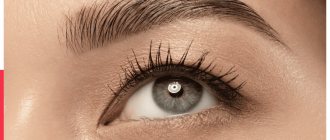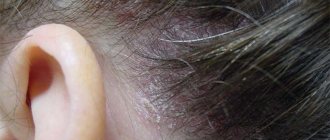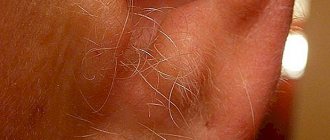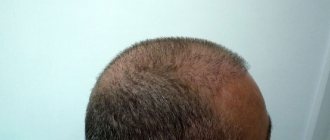Factors of occurrence
Thinning of strands does not happen spontaneously; it is preceded by a whole complex of reasons. In most cases, the influence is exerted by heredity and hormonal levels, but there are other common reasons for the development of the disease:
1. Dramatic weight loss due to strict diets; 2. Impaired functioning of the immune system, previous viral or infectious diseases; 3. Adverse environmental factors, poor ecology; 4. Malfunctions of the endocrine system; 5. Constant temperature changes; 6. Diabetes mellitus; 7. Menopause; 8. Previous surgical operations under general anesthesia; 9. Poor blood supply to the scalp; 10. Poor nutrition; 11. Lack of vitamins and microelements; 12. Bad habits; 13. Iron deficiency anemia; 14. Regular stress, severe emotional shocks; 15. Use of drugs to normalize blood pressure, steroids and diuretics, antidepressants; 16. Radiation and chemotherapy.
Types of male pattern baldness
Depending on the symptoms and manifestations, alopecia is divided into certain types.
Androgenetic
It occurs more often than others - in 90% of all cases. It is characterized by the fact that the hair becomes thinner only on the head, but the eyebrows, beard and eyelashes remain unchanged. In some cases, separate areas appear where hair growth, on the contrary, increases. The optimal treatment is mesotherapy. It occurs in 6 stages: 1. Thinning begins from the frontal part; 2. Then a receding hairline forms, resembling a triangle; 3. Areas without hairs become deeper and more noticeable, foci of hair loss begin to form on the crown of the head; 4. A rounded area appears where the fluff grows, and at the same time the affected areas increase; 5. The area of the crown and forehead gradually connects, only small areas with hair remain; 6. Complete loss of vegetation.
Varieties of this type of alopecia. There are: ● horseshoe - baldness begins from the forehead; ● nest - areas are formed without any order, after which a horseshoe-shaped bald patch gradually develops; ● mixed look.
Telogen effluvium
In this case, the curls do not receive proper nutrition, as a result they become brittle and lifeless. They fall out even with minimal touches and mechanical damage. Disturbances in telogen production can be caused by insufficient sunlight, general weakening of the body as a result of illness or taking potent drugs, hereditary or congenital pathologies. The disease can develop gradually or occur instantly.
Gnezdovoy
Here the hair roots are damaged, resulting in the formation of rounded bald patches on the head. In some cases, old areas are gradually overgrown and new ones appear in their place. This type is treated with the use of immunosuppressants, which block the action of body cells that destroy follicles. This type most often affects dark hair, which contains a high level of pigment.
Total
The final stage of alopecia. As the disease progresses, a man experiences complete hair loss not only on his head, but throughout his entire body. The process can last from a couple of months to several years, along with it the nails deteriorate and are destroyed. With this development of events, only a transplant can correct the situation.
Diffuse
Appears after exposure to certain factors, for example, prolonged stress, a course of antibiotics, or receiving a dose of ionizing radiation. It does not exist independently, separately from other types; most often it accompanies the androgenetic type. The main characteristic is that every day a representative of the stronger sex loses up to 100–120 hairs. In order to be completely cured, it is necessary to protect yourself from unfavorable factors that could cause the development of the pathological process.
Scarred
Occurs less frequently than others. Today, only every 70-100th case can be attributed to this species. The follicles are irreversibly damaged and are gradually completely replaced by connective tissue, that is, scarring occurs. The most common cause is scalp infections. Therefore, if treatment is started in a timely manner, the hair can be saved and gradually restored. A characteristic feature is that the follicle completely atrophies and ceases to function. Transplantation is the only effective treatment.
REASONS FOR THE DEVELOPMENT OF AGA
The development of AGA is based on genetically determined features of androgen metabolism in the hair follicle.
The most significant factor in men is increased activity of the enzyme 5α-reductase type II, which in genetically predisposed hair follicles metabolizes testicular testosterone to dihydrotestosterone (DHT).
In addition to the local metamorphoses of androgens in women, similar to those in men, in the pathogenesis of AGA, as a rule, a decrease in the activity of aromatase, which transforms
ovarian testosterone circulating in the blood into 17 beta-estradiol.
An increase in local DHT concentration leads to a progressive contraction of anagen due to a longer telogen phase (Fig. 3) and is accompanied by a progressive miniaturization of hair follicles. The latter is carried out due to relatively sharp reductions in the number of cells of the dermal papilla and dermal membrane.
In addition to androgen-dependent changes in the pathogenesis of AGA, the involvement of follicular microinflammation with the formation of fibrosis, provoked by the presence of bacterial flora, toxins and oxidative stress, has been proven.
Stages of alopecia
Acute forms and cicatricial type of baldness do not have distinct stages. In all other cases, the following are distinguished: 1. First signs. First, the curls become thinner and noticeably thinner. Visually, it is impossible to notice any violations of the cover, but the lack of overall volume and mass is obvious. 2. Noticeable manifestations. Several months or even years pass from the first stage to the second. However, the result is the same - bald patches and areas without strands form on the head, and the remaining hairs on the temples and back of the head become thin and lifeless, losing their natural shine and beauty.
First signs
If you notice that you have shaggy areas, bald spots, bald spots and other imperfections instead of your once rich and luxurious head of hair, you need to think about the state of your health and urgently look for the mechanism that triggered the pathology. However, the listed signs are evidence of an activated process that has taken a pronounced course and is gaining speed of development.
However, there are also cases when a person, seeing a minimal loss, begins to panic and worry. In fact, a person normally loses a certain amount of their hair every day. Usually it is up to 150 units per day. It is important to separate the norm from the pathology and, if alarming signs are identified, contact a specialist in a timely manner.
On average, one hair lives 3–7 years. At the end of this period, it falls out, and a new one appears in its place. If you notice that after using a comb, some units remain directly on it, or you find them on the pillow after sleep, do not worry - this does not indicate the development of baldness and is not evidence of the disease. Also remember that our strands do not grow at the same time, they are constantly renewed. But there is a constant reserve on the head, 90% or more percent - it never runs out.
Before you look for the answer to the question of what helps hair loss in men, you need to determine whether you are actually going bald. Analyze your current state. This can be done using the simple tests described below:
1. Carefully examine your skin to see if patches of baldness are beginning to form. 2. Pull the curls - they should not separate easily. 3. Inspect your clothes, pillow after sleep, the back of your work chair, sofa, coat. How many hairs do you lose and how regularly do they appear there? 4. Monitor yourself during the washing procedure. Do large strands remain in the drain hole? Continue to monitor this for 2-3 weeks to confirm or deny the development of pathology. 5. Gently comb your hair. Carefully inspect individual units; if you see a white tip on them, you need to sound the alarm and start taking action, as this means the loss of vegetation at the root. This is usually a direct symptom of baldness.
Hair transplant is an expensive illusion of salvation
Only a person who is completely ignorant of this issue and, as a rule, does not himself suffer from baldness, can believe in the effectiveness of hair transplantation. Despite the fact that transplantation has been known for about 70 years, its main defect remains: donor bulbs are obtained from the lower back of the head, which is usually not susceptible to AGA. The supply of bulbs is extremely limited, so transplantation is effective only for small stages of baldness, for example, bald patches on the forehead or a small bald spot on the top of the head. But the transplant does not eliminate the root causes of baldness, and most often AGA does not stop at this level, progressing further. A few years later we have a bald spot with funny bushes of transplanted hair, for which we paid at least 5000 - 7000 euros. The real advance for hair transplantation would be the cloning of new hair follicles, making it possible to plant bald spots of any size and thickness. But so far we have not heard of such a thing.
What to do first when dealing with hair loss in men
It is impossible to make a diagnosis and determine its stage on your own at home. To do this, you should visit a number of specialists:
● Therapist - to prescribe general tests (blood, urine) and initial consultation; ● Trichologist - trichogram to diagnose the condition of the hair; ● Dermatologist - performing scrapings and biopsies to examine for skin infections; ● Endocrinologist - to monitor hormone levels.
You need to contact an experienced specialist. The doctor will perform the necessary set of tests to assess the current condition and develop an optimal treatment plan.
After making a diagnosis, the doctor determines the cause of the disease. Therapy will be aimed specifically at eliminating them, and not at the signs of the disease.
If hair loss is not associated with serious disorders in the body, then restorative medications can be used. An excellent solution is to use Selencin, which is sold in the form of tablets, shampoo-rinse and stimulating spray. The product has proven a high degree of effectiveness in the fight against baldness thanks to the list of advantages: 1. Allows you to stop the process of hair loss within 2 months. 2. Affects the very root cause of the condition, and not its manifestations. 3. Stimulates the growth of new strands, allowing you to restore its former density. 4. Has a restorative effect, normalizes the life cycle. 5. Performs intensive nutrition and strengthening.
In addition to it, there are many universal products on the market that are suitable for both men and women. However, to achieve maximum results, the doctor prescribes a course of treatment depending on your condition. Often alopecia is a symptom of an underlying disease, which can be cured to eliminate receding hairline.
Medicines are no joke.
Today you are offered a symbiosis of 2 types of products: finasteride, dutasteride and propecia reduce the production of androgenic hormones allegedly responsible for baldness, minoxidil and alerana stimulate hair growth on bald spots. These drugs have been around for 30 years, if not more, and despite their time-tested weak, temporary effectiveness and dangerous side effects, they are successfully prescribed to patients. Beginners with naive faith and hope follow the advice of the “good” tricho-Aibolitov and... instead of hair on their bald head, they acquire impotence in the prime of their years. Because it is dangerous to mess with the “correction” of hormones; our body is much more complex than doctors think. Your fruits of treatment - thin hair, forcibly grown or kept in its rightful place through medicinal stimulation - resemble zombies raised from the grave, drug addicts, constantly demanding a dose, and even if they have it, their days are numbered. You yourself are literally sitting on the needle, taking 5,000-10,000 rubles a month from your family for medicines, until, in 5 years, you completely fall off.
What is prohibited in case of baldness
You have learned how to treat and fight hair loss in men, now let’s look at what you should never do. It is necessary to protect yourself from the effects of the adverse factors listed at the very beginning. Normalize your diet, make it balanced, eat at the same time.
Normalize the functioning of the immune system and the synthesis of hormones. It is also necessary to minimize workload and stress levels. It is also not recommended to: ● Overwork and work too hard. ● Stick to strict diets. ● Leaving a warm room in the cold - sudden temperature changes can trigger a pathological process. A hat will help smooth out the effects of hypothermia. ● Comb your hair harshly, using a towel now, after a shower. Such mechanical damage has a negative impact on the condition of the curls.
Diagnostics
When a patient comes to a trichologist with complaints of alopecia areata, diagnostic measures are carried out for him. Examinations help determine the type and degree of the disease. Even if the problem cannot be completely overcome, there is an option to put it into remission and ensure the safety of your hair.
Patchy baldness requires immediate medical attention. The pathology is poorly understood, and it is important to find out the reasons at the very beginning in order to prescribe adequate therapy. The treatment process requires patience and compliance with the specialist’s instructions.
Diagnostics may include:
- blood test for hormones;
- biochemical and general blood tests;
- microscopic hair analysis;
- analysis of cortisol levels;
- blood test for Epstein-Barr virus, toxoplasma and mycoplasma.
Additionally, the patient may be sent for consultation to a psychologist, dermatologist, or endocrinologist.
Message sent!
Prevention of alopecia in men
In order not to encounter a problem, constantly engage in prevention. The following tips will help with this:
1. Dry your head as carefully as possible, do not rub the skin. Otherwise, the follicles are damaged. 2. Do not pull or injure the strands during combing or other procedures that involve mechanical stress. This way you can cause enormous damage to the cover. 3. Do not wear wigs or synthetic products. Synthetic materials interfere with normal air exchange of the skin, which leads to the development of dandruff and bald patches. 4. Another tip is to use the right shampoo and conditioner that suits your hair type. It is not recommended to focus on cost and purchase the most affordable product in the store - this can lead to significant problems. 5. Don't wash your hair too often. This removes the natural protective layer of the strands and disrupts the functioning of the fatty glands, which protect the hair from adverse environmental factors. 6. Avoid chemically aggressive compounds, such as paints. If you want to change the color, use hair dyes based on natural ingredients. 7. Monitor your diet - calculate your daily intake of proteins, fats and carbohydrates. The diet should always contain foods rich in vitamins, minerals and trace elements.
Take care of your curls, regardless of gender and age, this will help maintain healthy shine, elasticity and volume for as long as possible.
Now you know how to slow down and stop hair loss in men and how you can avoid adverse consequences. Be healthy and beautiful!
Folk remedies
Traditional medicine can be used to treat alopecia. In order for them to have at least some effect and not cause harm, you should use traditional recipes only after consulting a doctor.
Often, to prepare formulations for home use you will need:
- burdocks;
- onion;
- hop;
- hot pepper;
- burdock.
Masks with these components help strengthen hair roots and awaken dormant follicles.
To improve blood microcirculation, masks are used:
- from aloe, honey, garlic;
- mustard;
- red pepper.
Some traditional healers recommend rubbing regular salt into the scalp. The method helps exfoliate dead skin particles.
Traditional medicine is usually used in courses. Each is 2 weeks, then a break of 5–7 days is recommended.










